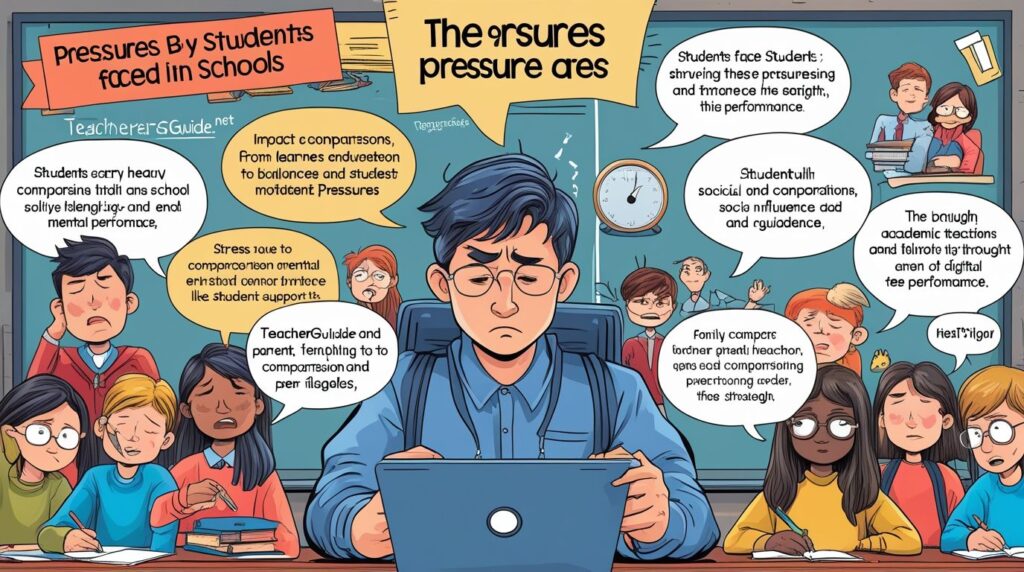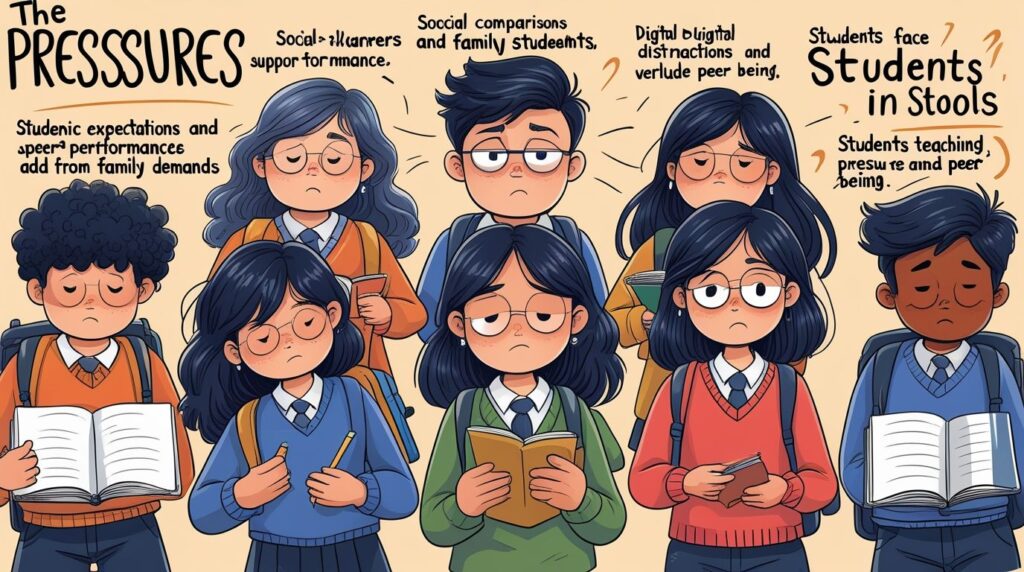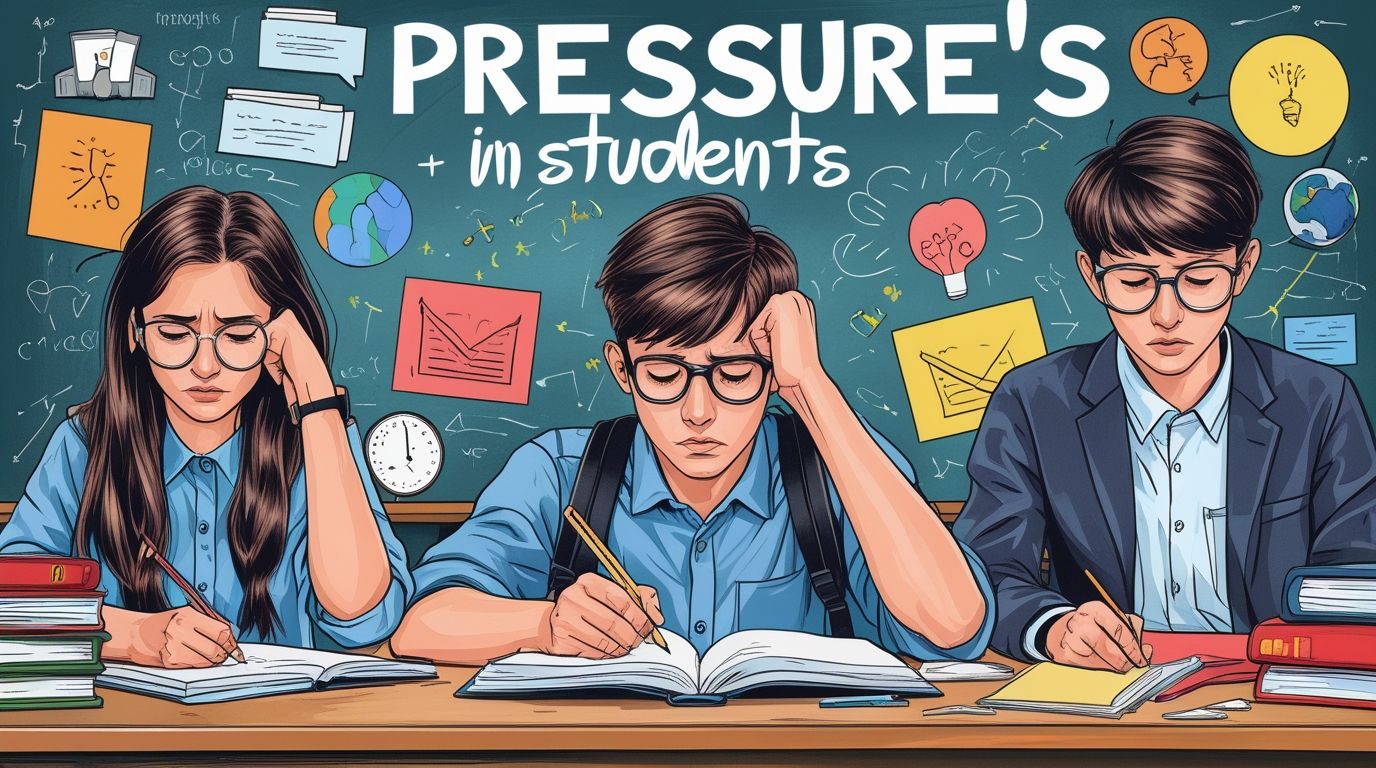Introduction:
In modern schools, students face many kinds of pressures. These pressures come from home, from teachers, and from society. They affect mental health, performance, behavior, and growth. Indeed, “academic stress” has become a dominant stressor in school environments. (Barbayannis et al., 2022) Frontiers Moreover, pressure interacts with family conflict, self-control, and well-being, creating a chain of challenges. (Jiang et al., 2022) Frontiers Teachers and parents often expect excellence. Students feel they must prove themselves every day. They fear failure. This means many students live in constant tension. In this article, I explore the pressures faced by students in schools. I discuss academic pressure, social pressure, emotional pressure, physical pressure, and coping strategies. Also, I point to resources like TeachersGuide.net for support and guidance.
Academic Pressure: Overwork, Exams, Expectations
Academic pressure is perhaps the most visible burden. Students often juggle heavy homework loads, frequent tests, and tight deadlines. Teachers demand top grades and fast progress. Further, parents raise expectations. Some students feel they must match or exceed siblings, or live up to family reputation. Consequently, they work late, skip breaks, and forego rest. Research shows academic stress can reduce motivation, harm performance, and increase dropout risk. Taylor & Francis Online Also, in a review, academic pressure was linked to anxiety, depression, and reduced mental health in adolescents. ScienceDirect Because of this, many students feel trapped. They cannot take breaks. They lose sleep. Their concentration suffers. In short, academic demands weigh heavily.
Social Pressure: Peers, Bullying, and Comparison
Beyond schoolwork, students face intense social pressures. They compare themselves with classmates. They worry about status, popularity, and acceptance. Bullying adds another dimension. Victims may suffer emotionally, socially, or physically. A large survey (95,545 students) found that bullying correlates strongly with depression, anxiety, and poor psychological health. arXiv Also, in adolescence, peer expectations influence behavior strongly. (Jiang et al., 2022) Frontiers When a student lags behind socially, they may feel isolated. They may suppress feelings or act out. Also, social media intensifies comparison. Students see curated lives of peers, then feel inferior. Thus, social pressure becomes a relentless background stress.
Emotional and Psychological Pressure: Anxiety, Depression, Self-Worth
Emotional pressures often go unnoticed until they escalate. Students feel stress, anxiety, fear of failure, and self-doubt. They may hide these feelings from parents or teachers. Repeated exposure to stress can cause mood issues, sleep problems, or depression. Studies note that high school students show significantly higher anxiety at the end of the school year than at its start. PMC Also, the link between academic pressure and depression or self-harm is well documented. ScienceDirect In addition, family conflicts or low self-control can magnify the emotional burden. (Jiang et al., 2022) Frontiers Over time, students may lose self-worth, feel hopeless, or detach from learning. Emotional pressure slowly erodes their resilience.

Physical and Health Pressures: Fatigue, Illness, Sleep
Stress does not remain merely mental. It manifests physically. Students often sacrifice sleep to finish assignments. Chronic insomnia becomes common. Their immune systems weaken. Illnesses occur more frequently. Tension headaches, migraines, stomach issues arise. Some skip meals or eat poorly. The fatigue carries into class. They cannot focus. Energy wanes. This becomes a vicious cycle. Studies of academic stress linked with physical symptoms, fatigue, and poor well-being. Nature Also, burnout is increasingly reported among students, not just professionals. BioMed Central Therefore, the body pays a heavy toll for mental strain. Schools must pay attention to these physical symptoms as warning signs.
Family Pressure and Home Environment
School pressures often extend beyond school. Families impose expectations. Parents may pressure students to take extra classes, attend coaching, or compete. In some homes, success in exams becomes the only approved aim. When students perform below expectations, conflict arises. Such parent–child conflict can mediate the effect of academic pressure on behaviour. (Jiang et al., 2022) Frontiers Also, some homes lack emotional support or resources. Students may have no quiet place to study. They may shoulder chores, sibling care, or financial concerns. When academic demands collide with these home duties, stress intensifies. In effect, the home environment can either buffer or magnify school pressures.
Time Pressure, Overcommitment & Extracurriculars
Modern students are stretched beyond school hours. They join clubs, sports, music lessons, volunteer work. They do this to build resumes or meet expectations. As a result, their schedules become crowded. They often multitask. They switch between homework, practices, rehearsals, social life. Time pressure makes rest or leisure nearly impossible. Overcommitment adds constant switching cost and mental load. They find little breathing time. This constant juggling adds to stress, reduces focus, and lowers quality of work. While extracurriculars have benefits, poor balance turns them into burdens. Many students simply feel there is not enough time to do everything well.
Role of School Environment & Teacher Expectations
The school environment also plays a role. Teachers may expect perfect behavior, punctuality, and constant engagement. They may pressure students with tight deadlines or high standards. Some schools emphasize test scores heavily, promoting a “score culture.” This increases competition and anxiety. Also, school culture may stigmatize failure. Students who fall behind are shamed or ostracized. Rigid curricula leave little room for flexibility. Moreover, lack of counseling or mental health support in schools worsens the issue. Students may feel they have nowhere to turn. In such environments, the institutional pressure compounds individual stress.
Digital Pressure & Technology Overload
Technology plays a dual role. It helps learning. But it also creates pressure. Students face constant notifications, homework apps, deadlines, and online assignments. They may connect to school systems outside class hours. This erodes boundaries. They feel they must respond even late at night. Social media adds to this. They compare themselves, feel the need to appear “successful,” and face FOMO (fear of missing out). The overload of screens also affects sleep, concentration, and mental health. In sum, digital pressure becomes part of the daily burden, making disconnection difficult.
Consequences: Burnout, Dropout, and Loss of Motivation
When pressure persists, negative outcomes follow. Burnout becomes real: emotional exhaustion, cynicism toward school, and reduced efficacy. Some students disengage or drop out. Others lose motivation entirely. School becomes a chore, not a source of growth. Performance declines. Mental health deteriorates. In extreme cases, self-harm or suicidal ideation can appear. The systematic review of academic stress showed clear links to depression, anxiety, and self-harm behaviors. ScienceDirect Also, academic stress can reduce well-being and degrade life satisfaction. (Barbayannis et al., 2022) Frontiers These consequences are not distant—they affect many students every year.

Coping Strategies: Individual Level
How can students cope? First, time management helps: scheduling, breaking tasks, realistic planning. Second, self-compassion matters. Accepting imperfection reduces pressure. Third, resilience training, mindful practices, breathing exercises, journaling—these help emotional health. Fourth, seeking help: peers, teachers, counselors. Talking about pressure lightens it. Fifth, building self-control and self-regulation helps mediate the link between pressure and negative behaviour. (Jiang et al., 2022) Frontiers Sixth, limiting screen time and setting boundaries helps digital overload. These strategies do not eliminate pressure, but they build buffers. Students should experiment, adapt, and maintain balance.
Coping Strategies: Institutional & School Level
Schools must also intervene. They can reduce excessive homework, redesign curricula, allow flexibility, and emphasize depth over coverage. All can adopt formative assessment over constant summative exams. They should build strong counseling services, mental health awareness, peer support groups, and safe spaces. Teachers can adopt supportive, empathetic approaches, giving timely feedback, pacing work, and encouraging breaks. Schools can educate parents about realistic expectations. They can partner with external programs offering mentoring or psychological support. Also, they can promote life skills, resilience training, stress-management workshops, and mindfulness programs. In that way, institutions can lighten student burden, support well-being, and preserve motivation.
Role of Educational Guides & External Resources
Guides and external resources can bridge gaps. For example, platforms like TeachersGuide.net offer lesson plans, educational support, and teacher help. (see internal link) By helping teachers plan better, reduce load, and adopt student-friendly pedagogy, such guides indirectly relieve student pressure. Also, mental health websites, helplines, student workshops, and parent education materials provide additional support. Students should use these resources proactively. Schools must promote them. Community programs can disseminate knowledge on stress, resilience, and coping. Together, these external supports create an ecosystem that cushions students from the brunt of pressure.
Equity & Differential Pressures
Not all students face the same pressures. Socioeconomic status, culture, gender, learning differences, family conditions all shape pressure experience. Students from low-income backgrounds may lack resources like private tutors or quiet study space. They may bear financial, work, or family obligations. They sometimes face discrimination or language barriers. Some students with learning disabilities struggle more under standardized pressures. Girls may face gendered expectations. Minority students may carry the burden of representation. Thus, pressure is not equally distributed. Interventions must consider equity, identify vulnerable groups, and provide targeted support. Otherwise, policies will help some but leave others behind.
Balancing Expectations and Growth Mindset
One way to ease pressure is promoting a growth mindset. Instead of demanding perfect grades, students and educators should emphasize improvement over time. Mistakes become learning points. With realistic expectations and emphasis on effort, pressure transforms into challenge. Teachers can frame standards as stretch goals, not rigid barometers. Parents can celebrate process rather than just results. Schools can accept that not all students excel in all areas. This balance helps reduce the weight of performance as sole validation. In sum, fostering growth mindset culture supports healthier pressure rather than destructive stress.
Future Directions & Policy Implications
To truly change, systemic policy revisions are needed. Governments and education boards should reconsider exam systems, reduce overload, and reconsider high-stakes testing. Mental health must be integrated into school mandates. Policies should require counseling, lower student–teacher ratios, fund support services, and monitor student well-being. Also, teacher training must include stress management, supportive pedagogy, and recognizing student distress. Research should continue, evaluating which interventions work best. Communities must treat student mental health as central, not side issue. With deliberate reforms, schools can transform from pressure factories to nurturing environments.
Conclusion
Students in schools carry heavy burdens. Academic, social, emotional, physical, family, and digital pressures interact and compound. Consequences include burnout, loss, and mental distress. But solutions exist. Individual strategies, supportive institutions, external resources like TeachersGuide.net, and systemic policy change can lighten the load. The goal is not to eliminate challenge—challenge is essential—but to ensure it builds strength, not breakdown. Schools must become places where students grow solidly, not stressfully. Only then can the next generation learn, thrive, and flourish.
References
- Barbayannis, G. et al. (2022). Academic Stress and Mental Well-Being in College Students. Frontiers in Psychology. Frontiers
- Jiang, M., et al. (2022). The influence of academic pressure on adolescents’ problem behavior: Chain mediating effects of self-control, parent–child conflict, and subjective well-being. Frontiers in Psychology. Frontiers
- Pascoe et al. (2020). The impact of stress on students in secondary school and higher education

av6ri0
wfz9rv
1j0hlg
I needed to draft you that little bit of remark to finally say thanks a lot over again for these gorgeous methods you’ve provided in this case. It is certainly unbelievably generous with you to offer easily exactly what most people might have made available for an electronic book to end up making some money for their own end, precisely since you might have tried it if you decided. The strategies as well worked as the fantastic way to recognize that the rest have the identical zeal just like my own to understand somewhat more with reference to this condition. I’m certain there are numerous more pleasant instances up front for individuals that read carefully your blog.
zzvvdw
Informasi akses situs Sigma slot
Wake up your way with this premium CD player alarm clock radio. Whether you prefer to rise with the AM/FM radio, your favorite CD, or a standard buzzer, this versatile alarm clock with CD player has you covered. Its intuitive design includes dual alarms, a large digital display, snooze/sleep timers, and USB charging for your phone. Enjoy high-quality stereo sound from a compact unit that fits easily on any bedside table or shelf. The best clock radios with CD player combine retro functionality with modern convenience—and this one leads the pack.
I’ve recently started a web site, the information you offer on this web site has helped me tremendously. Thanks for all of your time & work.
Hello there, I found your site via Google while looking for a related topic, your web site came up, it looks good. I have bookmarked it in my google bookmarks.
Very interesting topic, thanks for posting.
I’m not sure where you are getting your information, but great topic. I needs to spend some time learning much more or understanding more. Thanks for wonderful information I was looking for this info for my mission.
Thanks for sharing superb informations. Your website is so cool. I am impressed by the details that you’ve on this website. It reveals how nicely you understand this subject. Bookmarked this web page, will come back for extra articles. You, my friend, ROCK! I found just the info I already searched everywhere and just could not come across. What a perfect web-site.
hi!,I like your writing very a lot! share we keep up a correspondence extra approximately your post on AOL? I require an expert in this space to solve my problem. Maybe that is you! Taking a look ahead to peer you.
It’s perfect time to make some plans for the future and it’s time to be happy. I have read this post and if I could I desire to suggest you some interesting things or suggestions. Perhaps you can write next articles referring to this article. I desire to read more things about it!
Hello! Someone in my Facebook group shared this site with us so I came to check it out. I’m definitely loving the information. I’m book-marking and will be tweeting this to my followers! Terrific blog and wonderful design.
Hello. remarkable job. I did not anticipate this. This is a fantastic story. Thanks!
You’ve done a great job with this. I ended up learning something new without even realizing it—very smooth writing!
This post gave me a new perspective I hadn’t considered.
Thanks for taking the time to break this down step-by-step.
I always look forward to your posts. Keep it coming!
This was a great reminder for me. Thanks for posting.
You always deliver high-quality information. Thanks again!
This content is gold. Thank you so much!
I appreciate your unique perspective on this.
Your advice is exactly what I needed right now.
This helped clarify a lot of questions I had.
Thank you for sharing this! I really enjoyed reading your perspective.
This helped clarify a lot of questions I had.
I really appreciate content like this—it’s clear, informative, and actually helpful. Definitely worth reading!
This was easy to follow, even for someone new like me.
I’ll be sharing this with a few friends.
Such a thoughtful and well-researched piece. Thank you.
Thank you for putting this in a way that anyone can understand.
I appreciate your unique perspective on this.
I hadn’t considered this angle before. It’s refreshing!
I love how well-organized and detailed this post is.
I wasn’t sure what to expect at first, but this turned out to be surprisingly useful. Thanks for taking the time to put this together.
Your articles always leave me thinking.
Great job simplifying something so complex.
Such a simple yet powerful message. Thanks for this.
You’ve done a great job with this. I ended up learning something new without even realizing it—very smooth writing!
I really appreciate content like this—it’s clear, informative, and actually helpful. Definitely worth reading!
This was so insightful. I took notes while reading!
This content is really helpful, especially for beginners like me.
hi!,I love your writing so a lot! proportion we keep up a correspondence extra about your post on AOL? I require an expert in this house to unravel my problem. May be that’s you! Taking a look ahead to peer you.